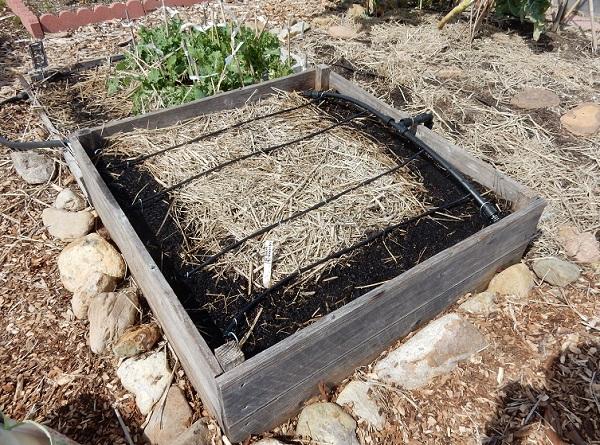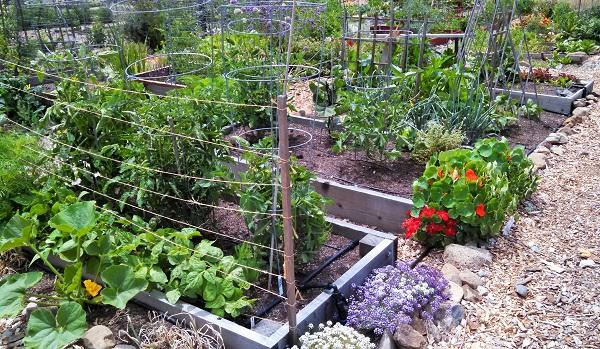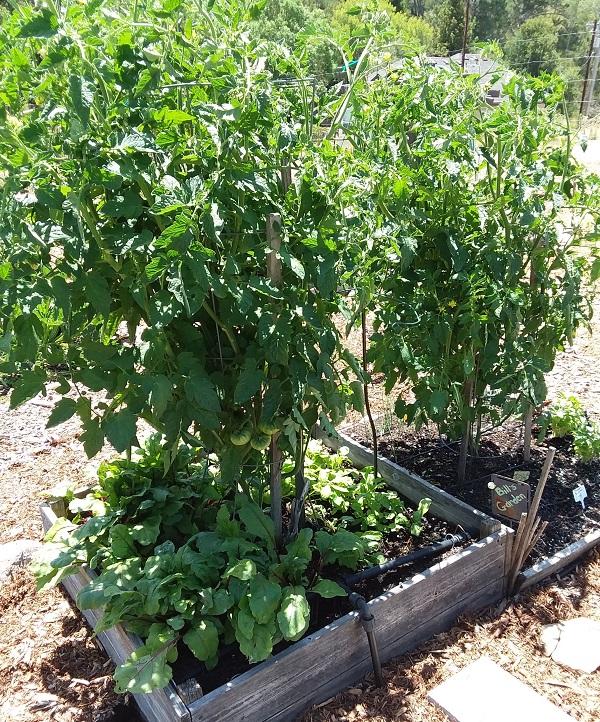
Food Gardening in a Drought
Growing food in a drought presents a number of challenges, difficult decisions, and actions to implement them. A critical issue is being aware of a limiting water budget—restrictions imposed by a city or county agency or a household well.
Planning a water budget is similar to other budget planning. In drought conditions, it means determining what water savings can be made to allow for a food garden. Possibilities are briefer showers; saving indoor water for outdoor use; turning off the tap unless absolutely necessary; flushing less; running the washer with full loads, using water-saving toilets and faucets; and installing a gray water system to irrigate landscape ornamentals.
Next comes determining how far the savings will stretch between household needs, garden bed size, and crop choices; then comes planting only what your family likes to eat and how much they can consume. Once you’ve made these determinations, put water-wise practices in place. Briefly, these practices include:
- Compost, compost, compost! Add organic matter to the soil. In sandy soil, organic matter allows the soil to hold more water. In heavy soil, organic matter opens up pore spaces to improve aeration and water movement, allowing roots to go deeper and access water at lower depths. Compost increases soil nutrition and better yields. With ample compost, no additional fertilizers are needed.
 Compost and rice straw mulch in raised bed. Arborist mulch in path. Photo by Stephanie Wrightson.
Compost and rice straw mulch in raised bed. Arborist mulch in path. Photo by Stephanie Wrightson. - Mulch, mulch, mulch!Mulch keeps soil cool, conserves moisture, and reduces weeds. Use 3-4 in. on top of the soil. The larger the material size, the deeper layer you need to provide. Choose from straw, fallen leaves, hulls, shredded bark, grass clippings and newspaper. It is not advisable to use plastic sheeting as mulch because it deprives the soil of much-needed oxygen. Keep mulch 2 in. away from the base of the plant to avoid the possibility of rot. When hand watering, pull back mulch so that water goes directly into the soil. And do not cover a seed bed with mulch until the seedlings are 3-4 in. tall. [Note: wood mulch, dried leaves, etc. would not be appropriate near the house from a fire-wise standpoint. Use 2 in. of well-decomposed compost on top of the soil to serve as mulch.]
- Use a drip system. Use a drip irrigation system for the most efficient application of limited water. Group plants that have the same moisture needs together on the same valve and irrigate only as long as it takes to moisten the active root zone. For most crops, the active root zone is 6-12 in., but deep-rooted perennial crops require moisture at least 1 ft. deep. Water in the morning or in the cool hours of the evening and only as much as needed so soil stays evenly moist, not wet. That is best accomplished by portioning out weekly water needs on a daily or every-other-day basis. The drip system efficiently delivers nutrients to the root zone where your crops need them. Monitor and adjust the drip system as needed.
During an average Sonoma County summer, water loss is about 1 in. per square foot a week due to evaporation and plant transpiration (ET). During extremely hot periods, it may be more. Water loss due to ET is what needs to be returned to the garden. Drip system in Stephanie's vegetable garden. Photo by Stephanie Wrightson
Drip system in Stephanie's vegetable garden. Photo by Stephanie Wrightson - Be selective.
- Learn about moisture needs of individual crops and grow only the amount and types of foods the family will consume. For example, plant two beds of vegetables instead of six; plant four tomatoes instead of ten.
- To get the most out of the water you apply, grow high yielding vegetables like beans, chard, mustard, eggplants, peppers, tomatoes, squash, quinoa, and amaranth.
- Consider which crops need the most water and when:
- Some beans and sweet corn need considerable water to produce a good crop. Beans need water most when they are blooming and setting fruit.
- Corn needs water most during tasseling, silking and ear development. Yield is directly related to quantities of water and nitrogen and spacing.
- Peas need water most during pod filling.
- Other vegetables, such as cucumbers and squash, and fruits, such as melons, need water most during flowering and fruiting.
- Tomatoes, peppers and eggplant need water most during flowering and fruiting. (Note that after tomatoes set, they can do very well with reduced water, or even no water after they start to ripen).
- Avoid crops that need consistent heavy moisture unless a particular variety has been bred to need less water. Most brassicas (broccoli, cabbage, Brussels sprouts, kohlrabi, cauliflower and radishes), lettuce and other greens, beets, carrots and other root crops, celeriac, celery, leeks and onions perform best with regular water.
- Generally, cool season crops are not drought resistant and growing them during the heat of the summer requires lots of extra water.
- After deciding what to grow, choose varieties labeled with the terms “drought-resistant” or “drought-tolerant” in seed catalogs or on plant labels (note that “heat-tolerant” refers to above ground air temperature and is not the same as drought-resistant or drought-tolerant). Selecting varieties that are described as “widely-adapted” in addition to drought-resistant and drought-tolerant also is helpful.
- Consider days to maturity. A crop needing fewer days to mature requires fewer irrigations before harvest (e.g., 62-day ‘Stupice’ vs. 85-day ‘Cherokee Purple’ tomato). Look for early-maturing or short-season varieties. Days to maturity will vary from one part of the country to another as well as from one microclimate to another.
- Plant intensively. In deep, loose soil or soil well-amended with compost, water penetrates more easily and roots grow deeper. This allows more intensive planting as more foliage creates shade reducing transpiration and evaporation. Use the spacing recommended in the Year-Round Gardening in Sonoma County document as a guide.
 Red and gold beets in shade of tomatoes. Photo by Stephanie Wrightson
Red and gold beets in shade of tomatoes. Photo by Stephanie Wrightson - Eliminate weeds. Weeds compete for water. Be aggressive in removing them from growing areas. Weeds also harbor pests that will take greater advantage of water-stressed crops.
- Use light-weight row covers. Cover plants as a means to collect dew. Dew drops onto soil and keeps it moist. While using row covers can help prevent insect damage, look under the cover from time to time to monitor plant growth and check for unwanted insects trapped inside. Crops such as squash must be (partially) uncovered once they flower to allow for pollination.
- Use shade. Heat-sensitive vegetables can benefit from being planted where they receive some afternoon shade. Plant them underneath or behind taller plants or consider using shade cloth or purposely-positioned outdoor furniture or beach umbrellas.
- Use windbreaks.The moisture on leaf surfaces is dried by moving air, causing plants to need more water. In windy areas, windbreaks help roots keep up with leaf demands.
- Determine when it is time to water again. Squeeze the soil in your hand: if it sticks together, it is still moist; if it is crumbly and falls apart, it is time to water. If you have drip irrigation, crushing the soil with your hand to test for moisture is difficult. Alternatively, you can put your finger or a chopstick in the soil near the drip emitter. If moist soil clings to your finger or chopstick, check again tomorrow. If you remove your finger or chopstick and it is dry, it is time to irrigate. Never irrigate before performing this soil test.
Additional Information
- Year-Round Gardening in Sonoma County
- Food Gardening with Less Water
- Composting
- Mulch
- Food Gardening Resources
October 2022









